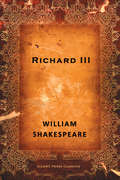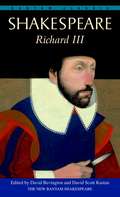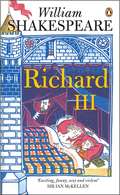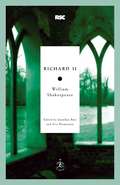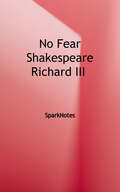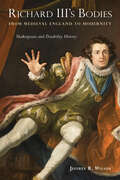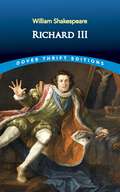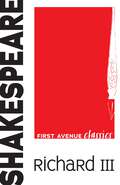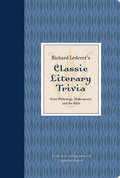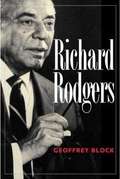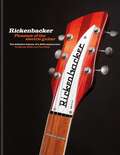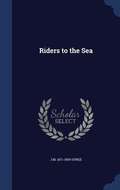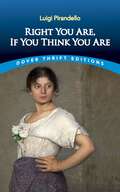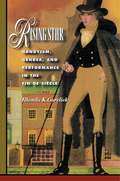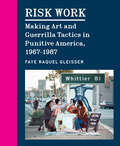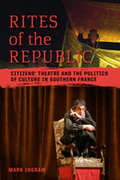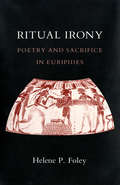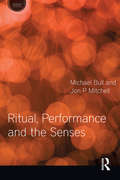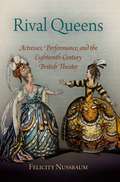- Table View
- List View
Richard III
by William ShakespeareAn account of the brutal and bloody rise of King Richard III to the throne, Shakespeare's play depicts the short-lived monarch's ruthless campaign for power, which resulted in the deaths of two of his brothers.
Richard III
by William ShakespeareRichard III, the hunchback Duke of Gloucester, becomes King Richard III through a series of manipulations and evil schemes. His ambition is the driving force for the plot and he finds little to stand in his way as he strives for domination of all of England.
Richard III
by William Shakespeare'Now is the winter of our discontent Made glorious summer by this sun of York'Shakespeare's final drama of the Wars of the Roses cycle begins as the dust settles on England after bloody civil war, and the bitter hunchback Richard, brother of the king, secretly plots to seize the throne. Charming and duplicitous, powerfully eloquent and viciously cruel, he is prepared to go to any lengths to achieve his goal. Richard III shows a man who, in his skilful manipulation of events and people, is a chilling incarnation of the temptations of power in a land shocked by war.Used and Recommended by the National TheatreGeneral Editor Stanley WellsEdited by E. A. J. HonigmannIntroduction by Michael Taylor
Richard III (Modern Library Classics)
by William Shakespeare Jonathan Bate Eric RasmussenAn exciting new edition of the complete works of Shakespeare with these features: Illustrated with photographs from New York Shakespeare Festival productions, vivid readable readable introductions for each play by noted scholar David Bevington, a lively personal foreword by Joseph Papp, an insightful essay on the play in performance, modern spelling and pronunciation, up-to-date annotated bibliographies, and convenient listing of key passages.From the Paperback edition.
Richard III (No Fear Shakespeare)
by SparkNotesRead Shakespeare's plays in all their brilliance--and understand what every word means! Don't be intimidated by Shakespeare! These popular guides make the Bard's plays accessible and enjoyable. Each No Fear guide contains: The complete text of the original play A line-by-line translation that puts the words into everyday language. A a complete list of characters, plenty of helpful commentary.
Richard III's Bodies from Medieval England to Modernity: Shakespeare and Disability History
by Jeffrey R. WilsonRichard III will always be central to English disability history as both man and myth—a disabled medieval king made into a monster by his nation’s most important artist. In Richard III’s Bodies from Medieval England to Modernity, Jeffrey Wilson tracks disability over 500 years, from Richard’s own manuscripts, early Tudor propaganda, and x-rays of sixteenth-century paintings through Shakespeare’s soliloquies, into Samuel Johnson’s editorial notes, the first play produced by an African American Theater company, Freudian psychoanalysis, and the rise of disability theater. For Wilson, the changing meanings of disability created through shifting perspectives in Shakespeare’s plays prefigure a series of modern attempts to understand Richard’s body in different disciplinary contexts—from history and philosophy to sociology and medicine. While theorizing a role for Shakespeare in the field of disability history, Wilson reveals how Richard III has become an index for some of modernity’s central concerns—the tension between appearance and reality, the conflict between individual will and external forces of nature and culture, the possibility of upward social mobility, and social interaction between self and other, including questions of discrimination, prejudice, hatred, oppression, power, and justice.
Richard III: Large Print (Dover Thrift Editions: Plays)
by William ShakespeareThe final play in Shakespeare's masterly dramatization of the strife between the Houses of York and Lancaster, Richard III offers a stunning portrait of an archvillain--a man of cunning and ruthless ambition who seduces, betrays and murders his way to the throne. In the process, Richard delivers great speeches and engages in formidable confrontations with a large cast of characters, almost all of them caught up in the terrible struggle for power that dominates the play. It is a tribute to Shakespeare's dramatic genius and knowledge of human psychology that by the end of the drama the detestable Richard begins to elicit some sympathy for the awful plight in which he finds himself. Explanatory footnotes and an introductory note are included.
Richard III: Large Print (First Avenue Classics ™)
by William ShakespeareTrouble is brewing for King Edward IV. Edward's youngest brother, Richard, is jealous of Edward's power and influence. Richard will do anything to overthrow the king: He manipulates a noblewoman into marrying him. He arranges for his brother Clarence to be executed, then blames Clarence's death on King Edward. After Edward becomes ill and dies, Richard attains the throne through villainous means. But Richard's trail of deception, manipulation, and murder might eventually be the cause of his own downfall. This unabridged edition of the history play written by English playwright William Shakespeare was written around 1592 and first published in 1597.
Richard Lederer's Classic Literary Trivia: From Mythology, Shakespeare, and the Bible
by Richard LedererIn this follow-up to Richard Lederer&’s Literary Trivia, the author delves into curious facts and anecdotes about mythology, Shakespeare, and the Bible. Through his numerous books and syndicated columns, Richard Lederer&’s infectious love of language and literature has inspired and intrigued readers for decades. Now the author of Lederer on Language and Anguished English delivers a volume full of fascinating trivia about some of Western literature&’s most foundational works. Here you will be able to test—and expand—your knowledge of the Bible, ancient Greek mythology, and the plays and poetry of William Shakespeare.
Richard Rodgers
by Geoffrey BlockGeoffrey Block examines the entire range of Rodgers's work, providing rich details about the creation, staging, and critical reception of some of his most popular musicals.
Rick: The Rick Hansen Story
by Dennis FoonFifteen-year-old Rick Hansen is confident, outgoing, and the star of his high-school basketball team. He has his whole life planned out, until a tragic accident severs his spinal cord, leaving him in a wheelchair. Rick's accident forces him to adapt his positivity to deal with his new life, while helping to strengthen the relationship with his guilt-stricken best friend. Refusing to be put at a disadvantage, Rick conquers the challenges presented to him with a smile and changes the definition of what it means to be disabled. Based on the true story of the man who inspired millions with his Man In Motion World Tour, Rick is a triumphant play that showcases the importance of optimism and perseverance, encouraging audiences to make their own paths to change the world.
Rickenbacker Guitars: The definitive history of a 20th-century icon
by Martin Kelly Paul KellyA STUNNING NEW AND COMPLETELY REVISED EDITION OF THE RICKENBACKER BIBLE FOR 2023'Knowing Martin and Paul Kelly's perfectionism and attention to detail it's no surprise that this is the ultimate and complete story of all things Rickenbacker.' - Johnny Marr'A wonderful history of my favourite guitar. The attention to detail is amazing!' - Roger McGuinn'There are few things more satisfying than the shimmer of an open chord played on a Rickenbacker through a Fender Deluxe Reverb amplifier. Martin and Paul have given us the definitive history of these magical instruments.' - Susanna HoffsRickenbacker Guitars is the highly anticipated follow up to Fender: The Golden Age, charting the story of one of the most important and influential guitar makers of all time. From George Beauchamp's invention of the world's first commercially viable electric guitar in 1931, through the company's heyday during the 1960s - when their instruments were favoured by The Beatles, The Byrds and The Who - and up to the continuing legacy of Rickenbacker today.This definitive collection features unprecedented access to the company archives, 350 beautifully photographed original instruments - including all 7 surviving Beatles owned Rickenbackers - and new interviews with legendary Rickenbacker players such as Roger McGuinn, Peter Buck, Susanna Hoffs, Johnny Marr, Mike Campbell, Geddy Lee and Paul Weller.Rickenbacker Guitars is the most comprehensive history of the brand to date and a must-have for all guitar enthusiasts.
Rickenbacker Guitars: The definitive history of a 20th-century icon
by Martin Kelly Paul KellyA STUNNING NEW AND COMPLETELY REVISED EDITION OF THE RICKENBACKER BIBLE FOR 2023'Knowing Martin and Paul Kelly's perfectionism and attention to detail it's no surprise that this is the ultimate and complete story of all things Rickenbacker.' - Johnny Marr'A wonderful history of my favourite guitar. The attention to detail is amazing!' - Roger McGuinn'There are few things more satisfying than the shimmer of an open chord played on a Rickenbacker through a Fender Deluxe Reverb amplifier. Martin and Paul have given us the definitive history of these magical instruments.' - Susanna HoffsRickenbacker Guitars is the highly anticipated follow up to Fender: The Golden Age, charting the story of one of the most important and influential guitar makers of all time. From George Beauchamp's invention of the world's first commercially viable electric guitar in 1931, through the company's heyday during the 1960s - when their instruments were favoured by The Beatles, The Byrds and The Who - and up to the continuing legacy of Rickenbacker today.This definitive collection features unprecedented access to the company archives, 350 beautifully photographed original instruments - including all 7 surviving Beatles owned Rickenbackers - and new interviews with legendary Rickenbacker players such as Roger McGuinn, Peter Buck, Susanna Hoffs, Johnny Marr, Mike Campbell, Geddy Lee and Paul Weller.Rickenbacker Guitars is the most comprehensive history of the brand to date and a must-have for all guitar enthusiasts.
Riders to the Sea
by J. M. SyngeThis work has been selected by scholars as being culturally important, and is part of the knowledge base of civilization as we know it. This work was reproduced from the original artifact, and remains as true to the original work as possible. Therefore, you will see the original copyright references, library stamps (as most of these works have been housed in our most important libraries around the world), and other notations in the work. This work is in the public domain in the United States of America, and possibly other nations. Within the United States, you may freely copy and distribute this work, as no entity (individual or corporate) has a copyright on the body of the work. As a reproduction of a historical artifact, this work may contain missing or blurred pages, poor pictures, errant marks, etc. Scholars believe, and we concur, that this work is important enough to be preserved, reproduced, and made generally available to the public. We appreciate your support of the preservation process, and thank you for being an important part of keeping this knowledge alive and relevant.
Right Bed Wrong Husband
by Neil SchaffnerFarce / 4m, 3f / Interior / In order to have his allowance increased, young bachelor Ted has written his pinchpenny uncle that he is married, though in fact he is only engaged. Suddenly one day uncle drops in unexpectedly, and very much against his will Ted is drawn into the vortex of an intrigue initiated entirely by the uncle when he mistakes a pretty girl, married to Ted's best friend, as Ted's wife. Ted is basically honest and does not want to deceive his uncle, but every time uncle kisses the "wife" he ups the ante to say nothing of kindling the ire of Ted's friend; and Ted is not sap enough to turn that down. Complications come tumbling after when the maid calls and is mistaken for something else; when the real fiancee returns and is caught kissing Ted; but especially at night then the time comes to retire. Add the neighborhood drunk who habitually sacks in with Ted when he's locked out of his own house, and you have a climax of enormous merriment.
Right You Are, If You Think You Are: Six Characters In Search Of An Author Henry Iv. Right You Are! (if You Think So) (classic Reprint) (Dover Thrift Editions: Plays)
by Luigi PirandelloWinner of the Nobel Prize for Literature in 1934, Italian playwright Luigi Pirandello (1867-1936) explored such themes as the relativity of truth, the vanity and necessity of illusion, and the instability of human personality. In this famous play, an expressionistic parable set in a small Italian town in the early twentieth century, Pirandello skillfully dramatizes these issues.The observer Laudisi derides the townspeople for their insistence on knowing the secrets of Mrs. Frola and her married daughter: Why does Mrs. Frola live alone and not with her daughter? Why do the two never visit each other? The answers to these questions lie at the heart of this play and at the center of Pirandello's artistic vision. Presented in an excellent new English translation, this inexpensive edition will delight students and lovers of modern drama.
Rio Bravo
by Robin WoodThis volume is a study of the classic western film Rio Bravo, which, according to the author, remains "beyond politics, as an argument as to why we should all want to go on living."
Riot Act
by Sarah LarivierePunk rock meets Orwell's 1984 in this story of a group of theater kids who take on a political regime, perfect for readers who love books by A.S. King and Marie Lu.In an alternate 1991, the authoritarian US government keeps tabs on everybody and everything. It censors which books can be read, what music can be listened to, and which plays can be performed.When her best friend is killed by the authorities and her theater teacher disappears without a trace, Gigi decides to organize her fellow Champaign High School thespians to put on a production of Henry VI. But at what cost?
Rising Star: Dandyism, Gender, and Performance in the Fin de Siècle
by Rhonda K. GarelickCelebrity personalities, who reign over much of our cultural landscape, owe their fame not to specific deeds but to the ability to project a distinct personal image, to create an icon of the self. Rising Star is a fascinating look at the roots of this particular form of celebrity. Here Rhonda Garelick locates a prototype of the star personality in the dandies and aesthete literary figures of the nineteenth century, including Beau Brummell, Baudelaire, Mallarmé, and Oscar Wilde, and explores their peculiarly charged relationship with women and performance. When fin-de-siècle aesthetes turned their attention to the new, "feminized" spectacle of mass culture, Garelick argues, they found a disturbing female counterpart to their own highly staged personae. She examines the concept of the broadcasted self-image in literary works as well as in such unwritten cultural texts as the choreography and films of dancer Loie Fuller, the industrialized spectacles of European World Fairs, and the cultural performances taking place today in fields ranging from entertainment to the academy. Recent dandy-like figures such as the artist formerly known as Prince, Madonna, Jacques Derrida, and Jackie O. all share a legacy provided by the encounter between "high" and early mass culture. Garelick's analysis of this encounter covers a wide range of topics, from the gender complexity of the European male dandy and the mechanization of the female body to Orientalist performance, the origins of cinema, and the emergence of "crowd" theory and mass politics.
Risk Work: Making Art and Guerrilla Tactics in Punitive America, 1967–1987
by Faye Raquel GleisserHow artists in the US starting in the 1960s came to use guerrilla tactics in performance and conceptual art, maneuvering policing, racism, and surveillance. As US news covered anticolonialist resistance abroad and urban rebellions at home, and as politicians mobilized the perceived threat of “guerrilla warfare” to justify increased police presence nationwide, artists across the country began adopting guerrilla tactics in performance and conceptual art. Risk Work tells the story of how artists’ experimentation with physical and psychological interference from the late 1960s through the late 1980s reveals the complex and enduring relationship between contemporary art, state power, and policing. Focusing on instances of arrest or potential arrest in art by Chris Burden, Adrian Piper, Jean Toche, Tehching Hsieh, Pope.L, the Guerrilla Girls, Asco, and PESTS, Faye Raquel Gleisser analyzes the gendered, sexualized, and racial politics of risk-taking that are overlooked in prevailing, white-centered narratives of American art. Drawing on art history and sociology as well as performance, prison, and Black studies, Gleisser argues that artists’ anticipation of state-sanctioned violence invokes the concept of “punitive literacy,” a collectively formed understanding of how to protect oneself and others in a carceral society.
Rites of the Republic: Citizens' Theatre And The Politics Of Culture In Southern France (Teaching Culture: Utp Ethnographies For The Classroom Ser.)
by Mark IngramIn this fascinating exploration of citizenship and the politics of culture in contemporary France, Ingram examines two theatre troupes in Provence: one based in a small town in the rural part of the Vaucluse region, and the other an urban project in Marseille, France's most culturally diverse city. Both troupes are committed to explicitly civic goals in the tradition of citizens' theatre. Focusing on the personal stories of the theatre artists in these two troupes, and the continuities between their narratives, their performances, and the national discourse directed by the Ministry of Culture, Ingram examines the ways in which these artists interpret universalistic ideals underlying both art and the Republic in their theatrical work. In the process he charts the evolution of new models for society and citizenship in a rapidly changing France.
Ritual Irony: Poetry and Sacrifice in Euripides
by Helene P. FoleyRitual Irony is a critical study of four problematic later plays of Euripides: the Iphigenia in Aulis, the Phoenissae, the Heracles, and the Bacchae.Examining Euripides' representation of sacrificial ritual against the background of late fifth-century Athens, Helene P. Foley shows that each of these plays confronts directly the difficulty of making an archaic poetic tradition relevant to a democratic society. She explores the important mediating role played by choral poetry and ritual in the plays, asserting that Euripides' sacrificial metaphors and ritual performances link an anachronistic mythic ideal with a world dominated by "chance" or an incomprehensible divinity.Foley utilizes the ideas and methodology of contemporary literary theory and symbolic anthropology, addressing issues central to the emerging dialogue between the two fields. Her conclusions have important implications for the study of Greek tragedy as a whole and for our understanding of Euripides' tragic irony, his conception of religion, and the role of his choral odes.Assuming no specialized knowledge, Ritual Irony is aimed at all readers of Euripidean tragedy. It will prove particularly valuable to students and scholars of classics, comparative literature, and symbolic anthropology.
Ritual and Event: Interdisciplinary Perspectives (Routledge Advances in Theatre & Performance Studies)
by Mark FrankoRitual today can be encountered in the midst of catastrophic and transforming events. This collection reassesses and revises traditionally understood relationships between ritual and politics, ritual and everyday life, ritual and art making, and ritual and disaster. The methodologies as well as the subject matter are interdisciplinary: they range from the anthropological to the art and dance historical, from the theatrical and literary to the linguistic, philosophical, and psychoanalytic. It will be a valuable tool for scholars of Theater and Performance Studies, as well as Anthropology, Art, and History.
Ritual, Performance and the Senses (Sensory Studies)
by Michael BullRitual has long been a central concept in anthropological theories of religious transmission. Ritual, Performance and the Senses offers a new understanding of how ritual enables religious representations – ideas, beliefs, values – to be shared among participants. Focusing on the body and the experiential nature of ritual, the book brings together insights from three distinct areas of study: cognitive/neuroanthropology, performance studies and the anthropology of the senses. Eight chapters by scholars from each of these sub-disciplines investigate different aspects of embodied religious practice, ranging from philosophical discussions of belief to explorations of the biological processes taking place in the brain itself. Case studies range from miracles and visionary activity in Catholic Malta to meditative practices in theatrical performance and include three pilgrimage sites: the Church of the Holy Sepulchre in Jerusalem, the festival of Ramlila in Ramnagar, India and the mountain shrine of the Lord of the Shiny Snow in Andean Peru.Understanding ritual allows us to understand processes at the very centre of human social life and humanity itself, making this an invaluable text for students and scholars in anthropology, cognitive science, performance studies and religious studies.
Rival Queens
by Felicity NussbaumIn eighteenth-century England, actresses were frequently dismissed as mere prostitutes trading on their sexual power rather than their talents. Yet they were, Felicity Nussbaum argues, central to the success of a newly commercial theater. Urban, recently moneyed, and thoroughly engaged with their audiences, celebrated actresses were among the first women to achieve social mobility, cultural authority, and financial independence. In fact, Nussbaum contends, the eighteenth century might well be called the "age of the actress" in the British theater, given women's influence on the dramatic repertory and, through it, on the definition of femininity.Treating individual star actresses who helped spark a cult of celebrity--especially Anne Oldfield, Susannah Cibber, Catherine Clive, Margaret Woffington, Frances Abington, and George Anne Bellamy--Rival Queens reveals the way these women animated issues of national identity, property, patronage, and fashion in the context of their dramatic performances. Actresses intentionally heightened their commercial appeal by catapulting the rivalries among themselves to center stage. They also boldly rivaled in importance the actor-managers who have long dominated eighteenth-century theater history and criticism. Felicity Nussbaum combines an emphasis on the celebrated actresses themselves with close analysis of their diverse roles in works by major playwrights, including George Farquhar, Nicholas Rowe, Colley Cibber, Arthur Murphy, David Garrick, Isaac Bickerstaff, and Richard Sheridan. Hers is a comprehensive and original argument about the importance of actresses as the first modern subjects, actively shaping their public identities to make themselves into celebrated properties.
